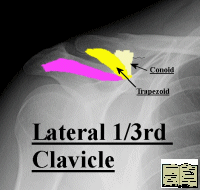Fracture lateral end of clavicle
Lateral 1/3rd clavicular fractures account for 1/4 of all clavicle fractures.
Non union occurs in roughly 1/3rd of cases, however only 1/3rd of these cases have a symptomatic non union requiring operative intervention.
Treatment is controversial, satisfactory outcomes have been reported
with primary non operative management and following primary open reduction and
internal fixation.
Classification
Neer (1968)
-
Type I - Injury lateral to coracoclavicular complex.
-
Type II - Injuries medial to the coracoclavicular complex. (II A medial to CC lig., IIB through conoid portion of CC lig.)
-
Type III - Intra-articular fracture of lateral end of clavicle.
Rockwood and Green
 |
|
Edinburgh Classification (1998)
-
Type 1 - The medial 1/5, ie area of clavicle lying medial to a vertical line drawn upward from the centre of the first rib
-
Type 2 - Middle 3/5ths
-
Type 3 - Lateral 1/5th of the clavicle, ie. lateral to a vertical line drawn upward from the centre of the base of the coracoid process, a point normally marked by the conoid tuberosity.
|
Type 3 Lateral 1/5th of the clavicle, ie. lateral to a vertical line drawn upward from the centre of the base of the coracoid process, a point normally marked by the conoid tuberosity. |
||||||||
|
Treatment
Robinson et al suggested a policy of nonoperative treatment for the majority of fractures of the lateral end of the clavicle in middle-aged and elderly individuals.
Primary surgical reconstruction should be reserved for individuals with severe soft-tissue compromise or a double disruption of the superior shoulder suspensory complex (floating shoulder).
Surgical reconstruction should be considered for patients with persistent discomfort associated with a nonunion or acromioclavicular osteoarthritis six months or more after the injury.
The most effective method of treatment for younger individuals (less than thirty-five years of age) is yet to be determined.
Robinson et al calculated the prognostic index which can be used to estimate probability of a lateral end of clavicle fracture remaining ununited at six, twelve, or twenty-four weeks. (NOTE Robinson refers to lateral end of clavicle fractures ie lateral 1/5th not lateral 1/3rd as in Neer classification)
See prognostic index calculators (Prognostic index calculator for lateral clavicular fractures)
Non operative
Immobilize in sling for comfort 2 weeks.
Initiate pendulum exercises progressing to passive and active range-of-motion exercises as comfort allows.
Isometric shoulder-strengthening exercises are commenced after six weeks.
Comments based on articles by Robinson et al:
Outcome following nonoperative treated patients are comparable with
those treated with primary operative treatment.
A delay in surgery does not seem to compromise the the final functional outcome.
Robinson et al suggested that six months is an acceptable cut off for non operative treatment, after which reconstructive surgery is usually required if the patient has persistent symptoms.
Operative management
Indicated for:
-
Severe soft-tissue compromise
-
Double disruption of the superior shoulder suspensory complex (Floating shoulder) (Not absolute indication)
-
Persistent symptoms >6 months post injury
-
Younger patient (controversial)
References
Neer CS 2nd. Fracture of the distal clavicle with detachment of the coracoclavicular ligaments in adults. J Trauma. 1963;3:99 -110
Neer CS 2nd. Fractures of the distal third of the clavicle. Clin Orthop.1968; 58:43 -50
Ritchie, Paul K; McCarty, Eric C; Distal clavicle fractures: a current review. Current Opinion in Orthopedics. 15(4):257-260, August 2004
Robinson CM; Cairns DA; Primary
Nonoperative Treatment of Displaced Lateral Fractures of the Clavicle; JBJS A-
Apr 2004; 86: 778 - 782.
Robinson CM, Court-Brown CM, McQueen MM, Wakefield AE; Estimating the risk of nonunion following nonoperative treatment of a clavicular fracture.; JBJS Am. 2004 Jul;86-A(7):1359-65.